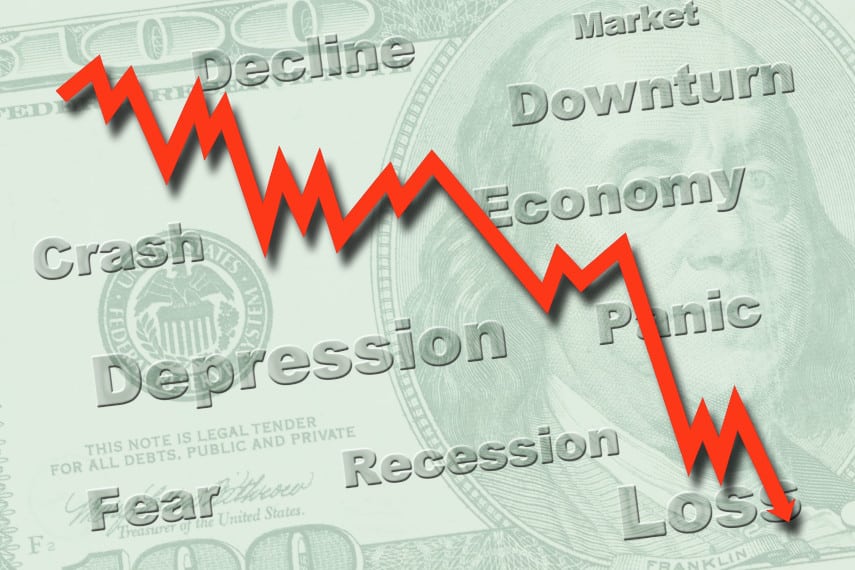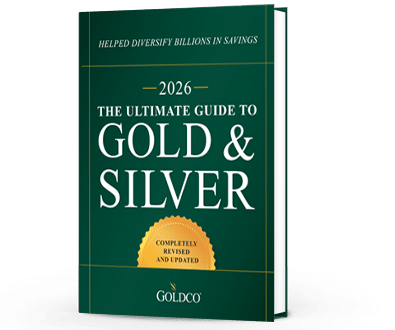6 Indicators of a Potential Recession
It seems that in the media today there are more and more mentions of the dreaded R-word: recession With growing economic uncertainty, the threat of potential recession seems to be growing as...
Economy

We’ve often written about how the next financial crisis might make the 2008 crisis look like nothing. That’s not just hyperbole, it’s a real fear. But the reasons behind that haven’t always been explained.
For some people, the thought that a major crisis may be just around the corner is a gut feeling, a hunch that, despite high-flying stock markets, something just isn’t right with the economy. Others may look at statistics like job growth, unemployment figures, or economic output and conclude that the economy is about to hit a rough patch.
The reality is that the arguments favoring a coming crisis are stronger than those favoring further economic growth. And there are six major factors contributing to the coming crisis that could cause it to be even bigger and more severe than 2008.
The underlying cause of the 2008 financial crisis was that the Federal Reserve manipulated interest rates too low for too long a period of time. Those low interest rates overstimulated the economy and caused resources to become malinvested, being placed into sectors of the economy and into capital production that was ultimately unsustainable.
We found that out the hard way in 2008, as the housing market that had previously been thought to be impervious to a crash began to collapse in amazing fashion. And along with the housing bubble crashing, Wall Street got taken down too.
What we’ve experienced since 2008 have been interest rates that have been historically and unprecedentedly low. Interest rates in the US were near zero for a decade, and are back to zero once again. Interest rates in other countries were forced into negative territory. If interest rates too low for too long precipitated the 2008 crisis, imagine what a decade or more of near zero interest rates has done to blow the bubble that will burst during the next crisis.
Along with low interest rates, the Fed has produced an unprecedented amount of money out of thin air. The immediate response to the 2008 crisis saw a huge amount of money being created, with the Fed’s balance sheet rising to over $4 trillion within a few years. But the past year has seen that money creation grow exponentially, with the Fed doubling its balance sheet to over $8 trillion.
All this money has to go somewhere, and it has flowed into markets. Prices for assets of all types have climbed, in many cases unsustainably. From food to houses to stocks, the trillions of new dollars circulating throughout the economy have driven prices higher and higher, putting severe pressure on American households whose wages haven’t kept pace with this money creation.
Perhaps even more problematic than the Fed’s actions to date is the fact that the Fed doesn’t have any room to maneuver. Interest rates are already at zero, so the only place left to go is negative, something the Fed doesn’t want to do.
The Fed’s balance sheet is already at an incredibly high level, and pushing it any higher risks severely distorting financial markets. In short, neither cutting interest rates nor engaging in further quantitative easing is feasible. If the Fed decides to engage in either, the negatives could significantly outweigh the positives. Thus the Fed has to risk doing nothing during a severe crisis or taking actions that could worsen the crisis.
Fueled by low interest rates, Americans have taken on more and more debt. Corporate debt is more than 50% greater than it was before the 2008 crisis, while American households have also pushed to record levels of indebtedness. And of course we all know that the federal government has engaged in some of the most unbalanced spending ever over the past two years.
These debt levels aren’t sustainable, with 20% of US companies thought to be zombie companies, those who can only afford to pay down the interest on their debt, not the principal. At some point these companies are going to face a reckoning, and when they do, it won’t be pretty.
Households are starting to have more difficulty paying off their debts, making them less likely to weather another crisis. And just like in 2008, one bankruptcy or default could set off a chain reaction that reverberates throughout Wall Street and Main Street. Only this time, the bubble is so much bigger that the effects could be significantly greater.
Stock markets are overvalued, and have been for some time. By many metrics they are more overvalued today than they were even during the dotcom bubble. That means that when the crash comes, the effects could be far worse than back then.
Many companies went out of business after the dotcom bubble burst, and many investors saw their previously high-flying stock holdings reduced to nothing. Overvaluation was a concern in 2008 too, and the correction during the crisis reached nearly 55% for US stock markets.
Even the short-lived lockdown-induced recession saw stock markets lose about 35% of their value. So the prospects for an actual cyclical correction to push stock markets to fall further could likely be even stronger.
One of the most jarring aspects of the current economy is the widespread complacence among many investors, especially those who should know better. After the dotcom bubble, the 2008 crisis, and the lockdown recession, many investors still believe that stocks are going to keep going up forever.
Many investors believe that Federal Reserve intervention has put an end to stock market struggles, or that the Fed will step in every time stock markets start to show signs of difficulty. That faith in the “Fed put” has caused numerous investors to miss the many obvious warning signs that stock markets are in danger of a severe correction.
Day trading has become almost as popular today as it was during the dotcom era. Retail investors have poured a record amount of money into stocks this year. And all of that could end very poorly once the correction occurs.
The thing about stock market corrections is that it’s a matter of when they happen, not if. Getting the timing exactly right is beyond the ability of most of us, which is why it very often makes sense to start taking steps to protect your wealth before a correction begins, rather than once it starts becoming obvious to everyone.
Investors who trusted gold during the 2008 crisis saw the value of their precious metals investments nearly triple in value, while those who invested in silver saw their investments more than quintuple. In response to last year’s mini-recession, gold and silver saw pretty good gains too, around 25% and 50% respectively. And the weaker the economy looks today, the higher the gold and silver price could rise.
With a massive bubble having been blown by the Federal Reserve, the stage has been set for that bubble to burst. When it does, it could take down millions of investors with it. Those who aren’t prepared, and who haven’t taken steps to protect their portfolios, could find themselves in severe difficulty.
That’s why so many investors have chosen gold and silver to help protect their valuable savings. With the track record gold and silver have had in protecting investors and providing growth potential during times of economic weakness, it’s no surprise that so many have turned to precious metals.
Goldco has helped thousands of customers protect their hard-earned savings with gold and silver. Whether you’re interested in protecting your tax-advantaged retirement savings through a gold IRA or just interested in putting some of your cash into a purchase of gold or silver coins, Goldco’s precious metals experts can help you through the process of buying gold and silver.
Don’t subject yourself and your wealth to the possibility of another 2008-like loss. Call Goldco today to learn more about how gold and silver can help safeguard your savings.

